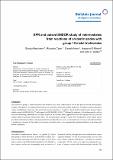Files in this item
EPR and pulsed ENDOR study of intermediates from reactions of aromatic azides with group 13 metal trichlorides
Item metadata
| dc.contributor.author | Bencivenni, G. | |
| dc.contributor.author | Cesari, R. | |
| dc.contributor.author | Nanni, D. | |
| dc.contributor.author | El Mkami, Hassane | |
| dc.contributor.author | Walton, John Christopher | |
| dc.date.accessioned | 2013-12-04T15:31:05Z | |
| dc.date.available | 2013-12-04T15:31:05Z | |
| dc.date.issued | 2010-08-09 | |
| dc.identifier | 9854257 | |
| dc.identifier | c95d2c3e-bd8c-4ef1-b86f-e4210fd28e9b | |
| dc.identifier | 000281426800001 | |
| dc.identifier | 77958516544 | |
| dc.identifier | 000281426800001 | |
| dc.identifier | 21049080 | |
| dc.identifier.citation | Bencivenni , G , Cesari , R , Nanni , D , El Mkami , H & Walton , J C 2010 , ' EPR and pulsed ENDOR study of intermediates from reactions of aromatic azides with group 13 metal trichlorides ' , Beilstein Journal of Organic Chemistry , vol. 6 , pp. 713-725 . https://doi.org/10.3762/bjoc.6.84 | en |
| dc.identifier.issn | 1860-5397 | |
| dc.identifier.other | ORCID: /0000-0003-2746-6276/work/56638852 | |
| dc.identifier.other | ORCID: /0000-0002-0552-5784/work/60195415 | |
| dc.identifier.uri | https://hdl.handle.net/10023/4263 | |
| dc.description | Funding: The authors thank EaStChem and the EPSRC (UK Basic Technology Programme grant GR/S85726/01) for financial assistance. We also acknowledge financial support from MIUR, Italy (2008 PRIN funds for ‘Properties and reactivity of free radicals in complex environments and their role in oxidative processes and in organic synthesis’). | en |
| dc.description.abstract | The reactions of group 13 metal trichlorides with aromatic azides were examined by CW EPR and pulsed ENDOR spectroscopies. Complex EPR spectra were obtained from reactions of aluminium, gallium and indium trichlorides with phenyl azides containing a variety of substituents. Analysis of the spectra showed that 4-methoxy-, 3-methoxy- and 2-methoxyphenyl azides all gave ‘dimer’ radical cations [ArNHC6H4NH2]+• and trimers [ArNHC6H4NHC6H4NH2]+• followed by polymers. 4-Azidobenzonitrile, with its electron-withdrawing substituent, did not react. In general the aromatic azides appeared to react most rapidly with AlCl3 but this reagent tended to generate much polymer. InCl3 was the least reactive group 13 halide. DFT computations of the radical cations provided corroborating evidence and suggested that the unpaired electrons were accommodated in extensive π-delocalised orbitals. A mechanism to account for the reductive conversion of aromatic azides to the corresponding anilines and thence to the dimers and trimers is proposed. | |
| dc.format.extent | 13 | |
| dc.format.extent | 1215524 | |
| dc.language.iso | eng | |
| dc.relation.ispartof | Beilstein Journal of Organic Chemistry | en |
| dc.subject | Aluminium | en |
| dc.subject | Aromatic azides | en |
| dc.subject | ENDOR | en |
| dc.subject | EPR | en |
| dc.subject | Gallium | en |
| dc.subject | Indium | en |
| dc.subject | QD Chemistry | en |
| dc.subject | MCC | en |
| dc.subject.lcc | QD | en |
| dc.title | EPR and pulsed ENDOR study of intermediates from reactions of aromatic azides with group 13 metal trichlorides | en |
| dc.type | Journal article | en |
| dc.contributor.institution | University of St Andrews. School of Physics and Astronomy | en |
| dc.contributor.institution | University of St Andrews. EaSTCHEM | en |
| dc.contributor.institution | University of St Andrews. School of Chemistry | en |
| dc.identifier.doi | https://doi.org/10.3762/bjoc.6.84 | |
| dc.description.status | Peer reviewed | en |
This item appears in the following Collection(s)
Items in the St Andrews Research Repository are protected by copyright, with all rights reserved, unless otherwise indicated.

